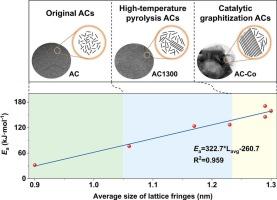高抗氧化气体吸附石墨化活性炭的合成研究
IF 9
1区 工程技术
Q1 ENGINEERING, CHEMICAL
引用次数: 0
摘要
抗氧化性能是制约活性炭工业应用的关键因素。为了解决这一问题,我们提出了两步活化-碳化策略来制备高孔隙率和抗氧化的石墨化活性炭。活化过程获得了发育良好的孔隙结构,随后的碳化过程促进了高温热解和催化石墨化,导致了短时间的微晶重组和官能团分解。在所测试的催化剂中,Ni对石墨化的催化作用最强,与Fe和Co相比,Ni显著提高了活性炭的石墨化程度和微晶尺寸。有趣的是,官能团的分解和微晶的生长是提高活性炭抗氧化能力的主要策略,其中平均微晶尺寸与氧化活化能呈线性相关。由于官能团含量低,石墨化程度高,在潮湿环境下,甲苯吸附容量损失从16.5 %降低到4.3 %,CO2吸附等等热降低。这项工作不仅为提高活性炭的抗氧化性提供了有效的策略,而且为其在气体吸附中的工业应用提供了有价值的见解。本文章由计算机程序翻译,如有差异,请以英文原文为准。

Insight into synthesis of graphitized activated carbons with high oxidation resistance for gas adsorption
Oxidation resistance is a critical factor restricting the industrial application of activated carbons (ACs). To address this issue, we propose a two-step activation–carbonization strategy to prepare graphitized ACs with high porosity and oxidation resistance. The activation process achieved a well-developed pore structure, while the subsequent carbonization process facilitated high-temperature pyrolysis and catalytic graphitization, leading to short-range microcrystalline reorganization and functional groups decomposition. Among the tested catalysts, Ni exhibited the strongest catalytic effect on graphitization, significantly enhancing both the graphitization degree and microcrystalline size of ACs compared to Fe and Co. Interestingly, the decomposition of functional groups and the growth of microcrystalline are major strategies for the increase in oxidation resistance of ACs, where the average microcrystalline size is linearly correlated with the oxidative activation energy. Owing to low content of functional groups and high graphitization degree, the loss of toluene adsorption capacity decreased from 16.5 % to 4.3 % in the humid environment, and the isosteric heat of CO2 adsorption decreased. This work not only develops an effective strategy for improving oxidation resistance of ACs but also provides valuable insights for their industrial applications in gas adsorption.
求助全文
通过发布文献求助,成功后即可免费获取论文全文。
去求助
来源期刊

Separation and Purification Technology
工程技术-工程:化工
CiteScore
14.00
自引率
12.80%
发文量
2347
审稿时长
43 days
期刊介绍:
Separation and Purification Technology is a premier journal committed to sharing innovative methods for separation and purification in chemical and environmental engineering, encompassing both homogeneous solutions and heterogeneous mixtures. Our scope includes the separation and/or purification of liquids, vapors, and gases, as well as carbon capture and separation techniques. However, it's important to note that methods solely intended for analytical purposes are not within the scope of the journal. Additionally, disciplines such as soil science, polymer science, and metallurgy fall outside the purview of Separation and Purification Technology. Join us in advancing the field of separation and purification methods for sustainable solutions in chemical and environmental engineering.
 求助内容:
求助内容: 应助结果提醒方式:
应助结果提醒方式:


